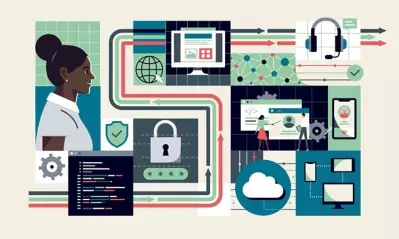Articles > Cybersecurity > Common cybersecurity threats and how to avoid them
Common cybersecurity threats and how to avoid them

Written by Michael Feder

Reviewed by Kathryn Uhles, MIS, MSP, Dean, College of Business and IT

In this article
Concerns over cybersecurity threats have grown as internet-connected devices and computer networks become a larger part of professional and private life. Cybercrime is currently one of the biggest menaces in the business world, where companies are prioritizing measures to protect themselves from various cybersecurity threats. The firm Cybersecurity Ventures predicts that cybercrime could cost the world $9.5 trillion USD in 2024 and increase to $10.5 trillion by 2025 .
Many IT risk-management strategies focus exclusively on these problems. Technology experts can help protect organizations from such threats as ransomware, DDoS and other forms of cyber attacks.
Mobile devices and the Internet of Things (IoT) have increased the number of targets for hackers and given rise to new cyber-attack strategies. Cyber crime has also opened the door to a new breed of computer specialists: cybersecurity experts. You can even pursue a Bachelor of Science in Cybersecurity if you're interested in this growing and challenging field.
Professionals who have a more general Bachelor of Science in Information Technology degree can also specialize via an Advanced Cybersecurity Certificate or a Master of Science in Cybersecurity to bring their technical knowledge to serve organizations navigating the dynamic security ecosystem. These programs impart the necessary knowledge for understanding evolving cybersecurity threats.
So, what are those threats exactly? Whether you choose a computer-related career in an organization or just want to ensure proper digital security in your everyday life, here are the different types of threats to be aware of.
Phishing
Phishing is an example of social engineering when hackers masquerade as a trusted entity and send digital messages, such as emails or texts, to manipulate individuals into helping them gain illegal access. These messages ask for secure information (like a password), or they have links that automatically install malware. The malicious programs can find and transmit sensitive data within your computer or incapacitate the entire network.
Cybercriminals will typically pretend to be reputable entities, such as well-known companies, so that you don't think twice before opening the link or entering your password. For example, a hacker might pretend to be from PayPal or Microsoft, and they may include official logos and other identifying marks in the email to make it seem legitimate.
You can spot phishing emails because they often have odd or lengthy email addresses or links to misspelled domain names. Knowing this can help protect you or your organization from this security risk.
Malware
Malware is intrusive software designed to interfere with a computer or transmit information to a third party. Malware is a blanket term for programs that steal or disrupt. Examples of malware include:
- Spyware, which gives a hacker access to your computer's files and data
- Adware, which spams your computer with pop-up ads
- Ransomware, which disables an entire network until you pay a ransom
- Keystroke tracking, which logs your keystrokes, including passwords
Hackers can send malware via file transfers, file-sharing programs or phishing emails. Often, the user will not know their computer has been infected with this cybersecurity threat.
Cryptojacking
Cryptojacking occurs when a hacker secretly uses a victim’s computing power to generate cryptocurrency. Typically, the hacker gets the computer owner to download a malware file, which installs a special crypto-mining program on the computer or other internet-connected device.
Since cryptojacking uses lots of memory, you may notice that your computer’s performance begins to lag. This type of cybersecurity threat can be particularly insidious since the program runs undetected in the background, and you're typically still be able to use the computer.
Man-in-the-middle attacks
A man-in-the-middle (MitM) attack occurs when hackers insert themselves into a two-party transaction. For instance, they may intercept communication between users and their credit card websites.
The goal of MitM cybercriminals is to commit a data breach and steal information from an organization, such as login details or a credit card number.
In some cases, the attack involves a hacker using a redirect or a pop-up when the victim is trying to get to an official site. Some attacks happen on unsecured public Wi-Fi networks, which allow the hacker to install malware or see data without having to get the victim to open a link or enter login details.
DNS tunneling
Despite being one of the most widely used and trusted internet protocols, the Domain Name System (DNS) protocol, despite being one of the most widely used and trusted internet protocols, has a vulnerability that hackers seek to exploit. DNS tunneling is a cyberattack that misuses the DNS protocol to sneak malicious traffic past firewalls and other security defenses.
Because DNS is a well-established and trusted tool, many organizations do not examine their DNS traffic for cybersecurity threats. Yet, cybercriminals with the right tech knowledge can insert malware using DNS queries and then transmit data back and forth without being detected by antivirus tools.
IoT attacks
The Internet of Things includes smart devices with embedded computer systems connected to Wi-Fi. These items, such as smart refrigerators, home security cameras and car navigation systems, typically have lax security.
Hackers can gain access to these devices and use them for denial-of-service attacks or cryptojacking. They can also access your network and see data and traffic details from other devices using the same connection.
SQL injection
SQL injection is a common cyberattack technique involving malicious SQL code. (SQL, or structured query language, is a domain-specific computer-programming language.)
Basically, the hacker manipulates the code in the system to gain access to databases that contain sensitive information. An SQL injection is relatively straightforward for someone who knows the code and can get access to the backend of a computer system.
They may modify the code to tell the system to display hidden data or trick the database application into retrieving sensitive data by changing the querying algorithms.
Denial-of-service attack
A denial-of-service (DoS) attack is meant to shut down a computer system or website so that legitimate users cannot access it. This type of cybersecurity threat can be carried out by flooding the servers with traffic. For example, if a site gets too many visitors, its servers will eventually slow down and stop. This type of attack can be difficult to stop because most websites are set up to attract traffic.
A hacker can also use malware to crash a website or computer system from the inside by disabling necessary databases or backend features.
Zero-day exploit
A zero-day vulnerability is a security flaw in a computer or other device's security system or device that has been discovered but has yet to be patched by software developers. A zero-day exploit occurs when a hacker takes advantage of this security flaw. Mobile devices can be particularly vulnerable to this type of attack because they receive frequent updates, while some apps are not updated with the necessary frequency. A hacker can gain access to the phone’s camera, location data and passwords in these situations.
Password attack
As its name suggests, a password attack is when hackers steal a password to gain access to an individual’s or organization’s computer systems and information. Hackers will often exploit legal means to gain unauthorized system access. For example, they may try recovering a user’s forgotten password. Usually, however, they steal passwords via phishing emails that request a victim's login or they'll change a password using a spoofed “official” site. Some password thieves rely on malware with keystroke tracking.
Cross-site scripting
Cross-site scripting (XSS) focuses on a security vulnerability in websites and applications. This cybersecurity threat enables attackers to create client-side scripts and put them on websites so that they can impersonate the victim. The site thinks the hacker is a legitimate user and gives them access to privileged information.
Typically, XSS targets websites or a company’s secure computer system. After gaining access, the hacker can navigate the network like a legitimate user and steal data or information.
Rootkits
A rootkit is designed to enable access that is otherwise not permitted without proper authorization or credentials. For example, this malicious software can allow access to secure computers, password-protected drives within a computer or secure apps on a smartphone.
Rootkits are particularly hard to detect because they mask their presence within an infected system. Furthermore, the software can help hide additional malware, such as keystroke tracking programs.
Cybersecurity experts learn to protect against, detect, counteract and destroy malicious software. Through the right degree programs, they also develop a skill base that will allow them to create strategies for fighting future hacking methods.
Learn more about counteracting cybersecurity threats
Cybersecurity experts learn to protect against, detect and destroy malicious software. Through the right educational program, they also develop a skill base that allows them to create strategies for fighting future cybersecurity threats worldwide. Possible online degrees and certificates include:
- An Advanced Cybersecurity Certificate
- An Associate of Science in Cybersecurity
- A Bachelor of Science in Cybersecurity
- A Cyber and Network Defense Certificate (for undergraduates)
These are all available at University of Phoenix. Request more information learn more.

ABOUT THE AUTHOR
A graduate of Johns Hopkins University and its Writing Seminars program and winner of the Stephen A. Dixon Literary Prize, Michael Feder brings an eye for detail and a passion for research to every article he writes. His academic and professional background includes experience in marketing, content development, script writing and SEO. Today, he works as a multimedia specialist at University of Phoenix where he covers a variety of topics ranging from healthcare to IT.

ABOUT THE REVIEWER
Currently Dean of the College of Business and Information Technology, Kathryn Uhles has served University of Phoenix in a variety of roles since 2006. Prior to joining University of Phoenix, Kathryn taught fifth grade to underprivileged youth in Phoenix.
This article has been vetted by University of Phoenix's editorial advisory committee.
Read more about our editorial process.


